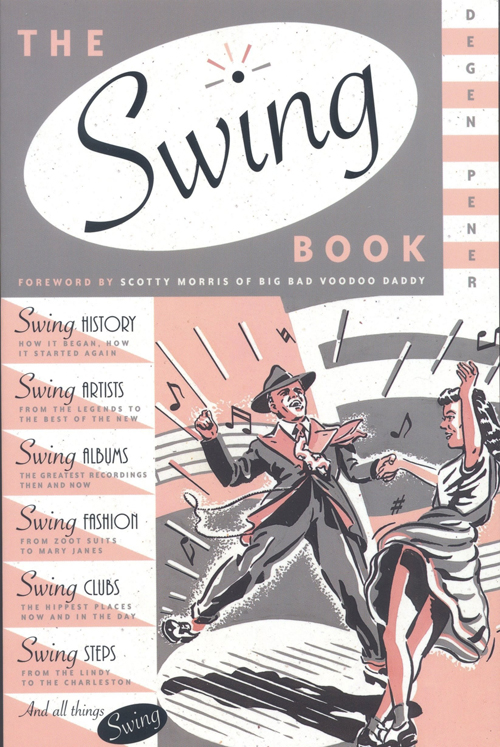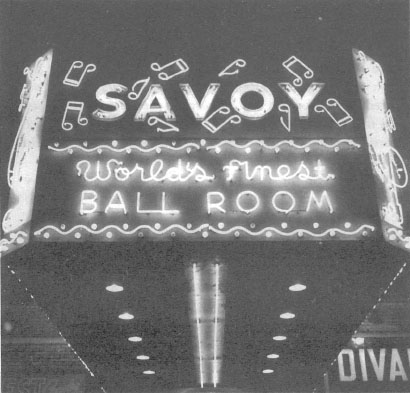The Swing Book
Authors: Degen Pener


Copyright © 1999 by Degen Pener
All rights reserved. No part of this book may be reproduced in any form or by any electronic or mechanical means, including
information storage and retrieval systems, without permission in writing from the publisher, except by a reviewer who may
quote brief passages in a review.
Hachette Book Group
237 Park Avenue
New York, NY 10017
Visit our website at
www.HachetteBookGroup.com
.
First eBook Edition: June 2009
ISBN: 978-0-316-07667-8
Contents
CHAPTER 1: The Golden Era of Swing
CHAPTER 2: The Rebirth of Swing
CHAPTER 3: What makes the Lindy Really Hop
CHAPTER 4: The Legends of Swing
CHAPTER 5: The Most Swinging New Bands
CHAPTER 6: From the Andrews Sisters to Zoot Suits: The Guy’ and Dolls’ to Guide to Retro Style
CHAPTER 7: A night on the Town: The City-by-City Guide
To the memory of my own Louis,
my grandfather Herman Louis Dammerman,
and for Richard Anderson
W
hat do I love about swing? I love the music, the history, and the legacy the legends have left for us to learn from. It’s
romantic, it’s powerful, and no other music I know of can move so many people. The bottom line is that it’s American music
and it’s our heritage. It’s not hype or a fashion statement, it’s jazz music. It’s as much Satchmo, Duke, and Krupa as it
is Dizzy, Bird, and Miles, and all I know is that when it’s done right, IT SWINGS.
With the rebirth of, or newfound interest in, swing music, you have a new batch of lions trying to make their mark on this
music. I know my influences range from the aforementioned, but also everything since, from the Beatles to Black Flag. In my
opinion, no great musical experience repeats itself, it moves on. It’s about the music and the moment. Everything else is
secondary.
What’s exciting about this moment right now is that all types of people are being turned on to this music. Bands like us,
and a handful of others, did it the old-fashioned way by building a nationwide following from the grassroots level. We decided
we would go out and win over every person, one at a time. We put on high-energy shows and toured relentlessly: the fans, they
appreciate that. They also know these bands aren’t a bunch of prefabbed groups that have been put together by some entertainment
company creating the next best thing.
Because the music is connected to dancing, each city has its own interesting scene. I love to watch the dancers from night
to night wherever we go; they are incredible. In some cities swing has just gotten going and it’s wild, there’s so much new
uninhibited energy. In cities that have been doing it for a while, you see some of the best, most intense dancing anywhere.
That is one thing that this music has brought back. Couples are dancing together and actually working off each other again.
It’s been over twenty-five years since people have gotten together like this.
I also like to see that people are now dressing up for these events. Women are wearing beautiful dresses, and guys are taking
pride in what they are wearing. It’s very romantic, and it’s all just a part of the show. If you come to dance, you’ll be
swinging to some of the best live music that’s out there today. If you come to be entertained, it’s one hundred percent. Watch
the dancers and they will blow your mind. Watch the band and you’ll be tapping your toes and singing along for a week.
When Big Bad Voodoo Daddy emerged almost a decade ago, people didn’t know what to think of us. All they knew was they were
having a great time and the music was exciting and fun. Well, not much has changed since then, and in the next couple of years
the new bands are going to prove what they are really made of. I think people will fall in love with this music more now than
ever before.
—
SCOTTY MORRIS, lead singer, songwriter, and founder of Big Bad Voodoo Daddy
A
t a remarkable event held on May 26, 1999, thousands of dancers, musicians, and lovers of all things swing gathered at New
York’s Roseland Ballroom to celebrate the birthday of a living legend. On that night, Frankie Manning—the original choreographer
of the most famous and thrilling troupe of swing dancers of all time, Whitey’s Lindy Hoppers—turned eighty-five years old.
Friends and strangers from around the world partnered up and hopped and spun to the music of the veteran Count Basie Orchestra
and the neoswing George Gee Orchestra. Brilliant zoot suits, sharp fedoras, classy rayon dresses, and sweet gardenias dotted
the crowd. From teenage Lindy Hoppers to longtime fans such as Bette Midler, they all came to fete Manning, the man who invented
the Lindy Hop’s outrageous air steps all the way back in the thirties. The dancer who blew away the room night after night
at Harlem’s famous Savoy Ballroom. And an entertainer who once traveled the world turning people on to the Lindy. Manning—whose
dance card was filled that night (eighty-five women danced with him, one for every year of his life)—seemed more vibrant and
alive than many people half his age as he soft-shoed the night away. For a few magical hours, it felt as though the swing
era had never ended.
Of course, it had. After most of the big bands disbanded in the late forties and partner dancing later fell by the wayside,
Manning’s career faded too. For thirty years he worked at the post office in New York. But Manning, like swing, was merely
dormant. In the 1980s and 1990s, dancers and musicians discovered swing all over again. People from Sweden to London and from
New York to California, caught up in an inexplicable wave of synchronicity, began learning how to dance the Lindy as it was
done back at the Savoy. Musicians started reviving the sounds of Louis Jordan, Louis Prima, and Basie. And these new swing
lovers tracked down Manning and gave him a beautiful gift: a second career as a dancer. Now he travels nonstop once again,
teaching the Lindy Hop, inspiring crowds wherever he goes, and living and breathing the music that keeps him so young.
Today, whether it’s a party as grand as Manning’s birthday do or a dance at the local club, swing nights are back everywhere.
Classes at dance studios are filled beyond capacity. Longing for a dash of glamour in their lives, people are dressing up
in the timeless looks of the forties. Guys and dolls are touching each other on the dance floor. Most important, swing music
is once again what it was created for: songs to dance to and not just listen to.
This book is meant as an introduction to the world of swing and its incredible rebirth. Inside you’ll discover how the music
and dance originally came to be and who the people were that brought it back. You’ll learn all about the Lindy, from its moves
to what makes it so much fun. You’ll meet the singers and musicians, both old and new, who swing the smoothest, croon the
sweetest, and even rock the hardest, plus find out what each artist’s best albums are. There’s an extensive guide to shopping
for the most stylin’ fashions of the thirties and forties. Finally, there’s a city-by-city listing of the top dance spots,
the best dance instructors, and the most up-to-date on-line events calendars across the country and even abroad. Whether you’ve
always loved this music and dance but felt you didn’t quite fit in or you’re finding out about swing for the first time, you’ll
find that there are now hundreds of places to enjoy it and meet like-minded fans, from Singapore to Dayton and from Saskatchewan
to Dallas.
While writing this book, the question I was constantly asked was why did swing come back? The answer is quite simple. Swing
ended prematurely. The peak years of the original era lasted from 1935 to 1945, just ten years. As a friend of mine, musician
Michael Kroll, observed recently, there have been so many musical movements in the twentieth century, and we’ve moved on so
quickly from one to another, that not all of them have been completely explored. “Did swing really have its full chance to
expand upon itself before rock ’n’ roll took it somewhere else? Maybe it just wasn’t finished,” says Max Young, co-owner of
San Francisco’s Hi-Ball Lounge. After years of being considered old-fashioned, even schmaltzy, swing has been rescued from
the nostalgia dustbin. “It’s about affirming what has come before,” says Rob Gibson, executive director of Jazz at Lincoln
Center. “We’re saying that was good, let’s build on that.”
With the swing revival, the music and the dance that have been called America’s most important contributions to the world
are taking their proper place in our culture. We are owning our heritage. In the process, we are also discovering that the
real roots of swing are as fresh and compelling and full of life as ever, and that the music and dance can grow and inspire
new artistic creation. “The question isn’t why did it come back. The anomaly is that it ever went away,” says Bill Elliott,
founder of the neoswing Bill Elliott Orchestra. But that’s the beauty of swing. It’s always capable of swinging back.

The marquee of the elegant Savoy Ballroom, also known as the “Home of Happy Feet.”
(A
RCHIVE
P
HOTOS
)

T
rying to define the term
swing
is as difficult as attempting to do an air step at your first dance class. Even the great Louis Armstrong was silent on the
subject. “They asked him, ‘What is swing?’ and he thought for a while and said, ‘If you don’t know, don’t mess with it,’“
recalls jazz legend Lionel Hampton, who first played with Armstrong back in 1930. Another swing innovator, Benny Goodman,
the so-called King of Swing, admitted that describing the music left him just as flummoxed. Swing, he once said, “is as difficult
to explain as the Mona Lisa’s smile or the nutty hats women wear—but just as stimulating. It remains something you take 5,000
words to explain then leaves you wondering what it is.” Now, more than fifty years after the movement first started, swing
is more of a muddled concept than ever. Does swing equal jazz? Is swing the same as big band music? Is swing exclusively a
dance music? And is there any such thing as pure swing? Contrary to many people’s assumptions, the most accurate answer to
each of those questions is no.
In true technical terms, swing isn’t a particular type of music at all. It’s a way of playing music, the manner in which a
beat moves, something you can hear and feel and, best of all, do. As bandleader Artie Shaw has said, “Swing is a verb, not
an adjective.… All jazz music swings. It has to. If it doesn’t swing, it’s nothing.” Unlike the finality expressed in a pounding
rock beat, each pulse of truly swinging music contains in it an open, joyous space of possibility, even if the song is a hard-luck
blues tune. “Jazz or swing—it’s all the same as long as it has that beat,” Ella Fitzgerald once said. “Just about any kind
of music can swing,” says Johnny Coppola, a trumpeter once in the bands of swingers Charlie Barnet, Woody Herman, and Stan
Kenton. “A good marching band can swing. Bach played right can swing.”